




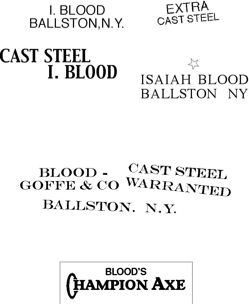
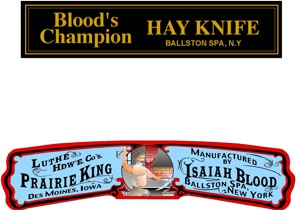


Comments, feedback and additional input are always welcome. Additional information or suggested corrections should be accompanied by verifiable sources or copies of same.
Please Contact:

Click on one of the other topics in the menu box at the top to go to a different department or article.
What was to become known as the Blood Axe Factory was originally started in Ballston, New York by Sylvester Blood. Sylvester Blood had learned his trade elsewhere and after being located in the Worcester, Massachusetts area relocated to the Ballston, New York area. In 1824 he started making scythes and axes in a shop that he established on the Kayaderosseras River. It is not specifically known if any of his four sons actually worked in the shop but history relates that the shop included a trip hammer driven by a water wheel. Indications are that initially the undertaking may have been a blacksmithing operation but soon concentrated on scythes and axes. Considering the times, it may well have been that the business was referred to as the Blood Shop or the Blood Factory.
In 1837, at the age of 30, Isaiah Blood took over running his father's axe and scythe manufacturing business. Isaiah had already established himself in the military and apparently had become an active businessman in the area. He expanded the works to include a second water privilege* and developed a manufactory that became known throughout the country. The community in which the Blood factories were located was just north-northwest of Ballston Spa and by the 1850s it had acquired the name Bloodville. There is some discrepancy about the actual date with some citing 1854 but it is believed that 1851 is actually correct. By 1866 the community had grown to the point where it was included in The New Topographical Atlas of Saratoga County, New York, published by Stone & Stewart, Philadelphia 1866 under the name Bloodville.
It was around the end of the 1840s that another axe works was established by two men who were reportedly from Cohoes. The firm took it’s name from the owners Goff(e) & Orlop but the undertaking was very short-lived. In late 1851 or 1852, Isaiah Blood entered the partnership and the business became Blood, Goff & Orlop. By mid- 1854 Orlop withdrew and shortly thereafter George Thomas invested in the venture. It may be that Isaiah Blood also increased his percentage in the business at that time. Indications are that the business was then called Blood-Goffe & Co. as that marking has been observed on some axes. For some reason the name Goff was spelled Goffe. That partnership was also short-lived with Isaiah Blood soon buying out the other partners and using the works to expand his other edge tool business more heavily into axes. The expansion was initiated by a major fire in early July of 1854 that resulted in Blood rebuilding on a much larger scale.
A map from the 1870s shows that I. Blood owned a number of parcels of land in the community which at the time included parts that were in the towns of Milton and Ballston. It was located just north of Ballston Spa. Blood’s abundant land holdings apparently prompted the adoption of the name Bloodville. Included were a scythe factory located just below the most northerly dam and the axe factory located just below the center dam. Quite probably a number of the properties marked with I. Blood's name were locations of residences and/or accommodations where factory workers resided.
Isaiah was also involved in politics and he eventually was elected as a State Senator from Saratoga County. That position apparently impacted on his success in business and the awarding of a commission to provide what became known as "Blood's Battle Axes" for use in the Civil War. Producing the specialized items in his own factory further elevated his notoriety. Isaiah Blood was also referred to as Col. Blood, a title he apparently had achieved by the beginning of the Civil War. He had already achieved the rank of Major before he took over the axe and scythe factories.
As time progressed the business functioned under the names BLOOD COMPANY and BLOOD & COMPANY. Upon his death in 1870, the Hon. I. Blood bequeathed the axe and scythe factories to his only daughter, Helen who was already married to Henry Knickerbacker. Henry then took over the operations of the business and changed the name of the company to the Knickerbacker Axe Co. but he maintained the brands and labels that were associated with the company when it was run by his father-in-law. Indications are that Henry continued to build the business as an axe and scythe-making establishment. In addition, other edge tools continued to be made.
Sometime between 1889 and 1891 the Knickerbacker Axe Company joined the American Axe & Tool Co. By the early 1890s the demand for labor rose to between two and three hundred men in the various shops. Axes and scythes were the leading products accounting for a production of 12,000 and 8,000 dozen respectively per year before the company joined the A. A. & T. Co. Other forged edge tools accounted for approximately 10,000 dozen per year.
Bloodville was actually a suburb of Ballston Spa and because that name was more recognizable it was used when referring to the location of the company. That policy was continued by the A. A. & T. Co. by referring to the factories located there as their Ballston Spa Plant. Indications are that the A. A. & T. Co. actually promoted the use of the name “American Edge Tool Co.” in regard to the company name. The specifics of that name usage is unclear at this time but another company that had joined the A. A. & T. Co. also functioned under that name along with their more common name of The Johnsonville Axe Co.
Sometime in the mid-1890s (some accounts indicate as late as March 13, 1900) the scythe plant was destroyed by fire. It was not rebuilt but some salvaged equipment was relocated to Glassport, PA. the main campus of the A. A. & T. Co. The axe factory continued operations until it too was destroyed by fire. Again, some salvaged equipment was relocated to Glassport, PA. After that the A. A. & T. Co discontinued all operations in Ballston Spa.
BALLSTON, NEW YORK 1824-1851
BLOODVILLE, NEW YORK 1851-1870
By Tom Lamond ©

NOTE: Power was extremely important to factories, primarily so they could operate the mechanical equipment. The term “water privilege” meant the right to a peculiar benefit, advantage or favor involving water that was under the control of an individual or company wherein it could be used as a source of power. It referred to the right to use water from a given source such as a river or a millpond that included a dam. Water accumulating in a contained area could then be regulated as it was channeled past the dam thus increasing the force and regulating the amount of the water. If the storage area was deep enough the waterpower could be delivered even if there was ice on the top of the reservoir. Considering that water was the primary source of mechanical power at the time, access to that power was paramount in operating manufactories. In some cases factory and mill owners formed partnerships that financed the building of dams to insure they had power. Those in control then would sell the use of the waterpower to other users. In some cases multiple dams were built along a river especially if there was a significant drop in elevation along the river. That helped to maximize the power and often increased the number of users.
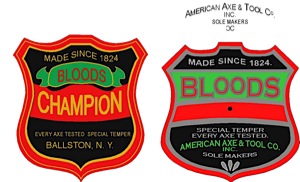
Early I. Blood version of the Champion label compared to that used after the A. A. & T. Co. acquired the rights to use the label. (Facsimiles)
Facsimiles of Champion labels prior to the Knickerbacker Axe Co. joining the A. A. & T. Co.
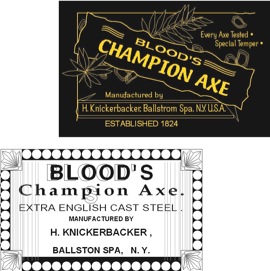

Representation of the sword I. Blood designed and then manufactured for the U. S. military.
Representation of a marking used on some axes for only a short period of time.
Representations of a marking used on some early I. Blood axes.
Representation of a marking used on some axes after I. Blood adopted the use of the Champion brand name.


Facsimile of a paper label used by the Cohoes Axe Mfg. Co. Note the similarity of the "Smithy" graphic. It is believed that the name COHARCO TOOL WORKS was used by the Cohoes Axe Mfg. Co. as an alias for marketing purposes.
Upper facsimile and center photo of two scythe labels included in a 1911 American Axe & Tool Co. catalog. The Prairie King facsimile is of a scythe label included in a 1910 Luthe Hdw'e. Co. catalog. Based on the label date, the actual scythes were probably made by
the American Axe & Tool Co. at the time.
The 505 label prior to the A. A. &T Co. acquisition.
This label was also used by the
Knickerbacker Axe Co.
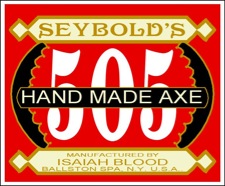

MORE INFORMATION:
Cross reference articles published on the YesteryearsTools web site that relate to this article; Knickerbacker Axe Co. and American Axe & Tool Co.
